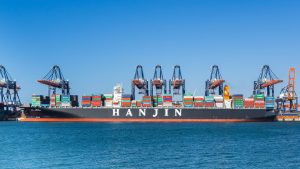Just 3 months ago, South Korea’s largest shipping company was placed under receivership due to its failure to pay its creditors. The ensuing chaos plunged the entire global shipping industry into crisis; ports were unwilling to accept Hanjin vessels in, for fear of being left without compensation; companies feared creditors would claim their products as collateral etc. This left vessels drifting out in international water s, dwindling on fuel and supplies that Hanjin could not afford to replenish. It is without a doubt that Hanjin’s bankruptcy will have lasting reverberations throughout the global supply chain. So how did such an operational catastrophe erupt?
s, dwindling on fuel and supplies that Hanjin could not afford to replenish. It is without a doubt that Hanjin’s bankruptcy will have lasting reverberations throughout the global supply chain. So how did such an operational catastrophe erupt?
The origins of Hanjin’s financial difficulties can be traced back to various factors from the macro environment that affected its business, such as the 2008 financial crisis, the eurozone crisis, and even China’s economic slowdown. Hanjin is inevitably prone to these sorts of macro trends because their key activities are at the heart of the global supply chain. In April of 2016, Hanjin forfeited management control to its largest creditor, Korea Development Bank, symbolizing its dire circumstances it was under. Hanjin would go onto miss interest payments to shipowners, culminating in its filing for bankruptcy on August
31st of 2016.
So what exactly are the lasting shockwaves it sends through the global shipping industry? The most imminent of consequences will be the ubiquitous lack of supply of shipping freights to cope with high demand to ship products from China. For example, Hanjin moved approximately 10% of freight from Asia to Europe; they were evidently a crucial intermediarie in many businesses supply chains. Thus it is clear how Hanjins bankruptcy demonstrates systemic risk to the entire global supply chain: Hanjin was a substantial component for many businesses, as being the crucial link between a companies value proposition and their customer segments.
How could have Hanjin avoided this catastrophe? Perhaps management could have applied useful metrics as preemptive measure against financial and operational viability. By applying various metrics, management could have attained a more accurate perspective of its position and direction, for better or worse. In Hanjin’s case, metrics could have been used to assess their current posistion and interpret the data to make meaningful management decsions that were preserving to the companys financial health. As the global economy heads into one of its busiest times (Christmas), all eyes will be kept on the operational efficiency of the global supply chain.
Word Count: 405
Photo Credit: https://www.linkedin.com/pulse/hanjin-immediate-consequences-bhargavi-s-jannu
Sources: http://www.morethanshipping.com/impacts-hanjin-shippings-sudden-collapse/
http://www.zerohedge.com/news/2016-09-02/ripple-effect-could-be-tremendous-retailers-demand-government-bailout-after-hanjin-c